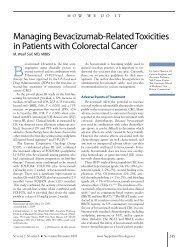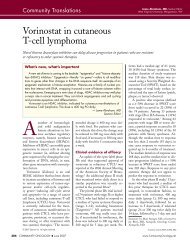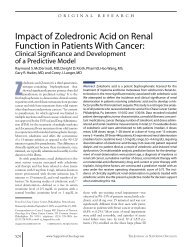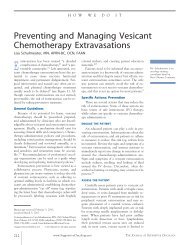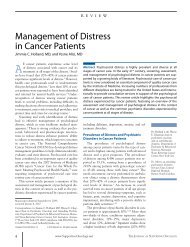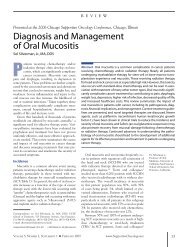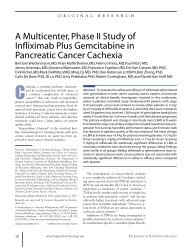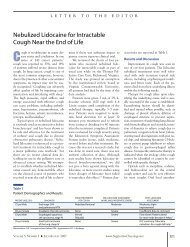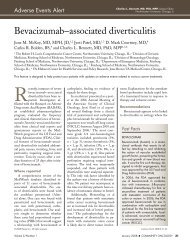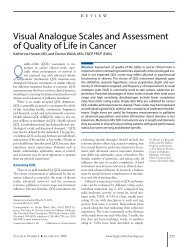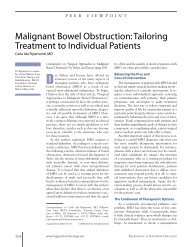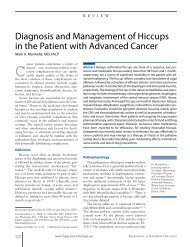Evaluating the “Good Death” Concept from Iranian Bereaved Family
Evaluating the “Good Death” Concept from Iranian Bereaved Family
Evaluating the “Good Death” Concept from Iranian Bereaved Family
You also want an ePaper? Increase the reach of your titles
YUMPU automatically turns print PDFs into web optimized ePapers that Google loves.
Symptom Experience in Patients with Gynecological Cancers<br />
potential participants were provided with a detailed information<br />
sheet and had a discussion with <strong>the</strong> research nurse. Upon<br />
agreement, patients signed a consent form and <strong>the</strong> first interview<br />
was scheduled. Participants were followed up for one<br />
year. Past experience, judgment on <strong>the</strong> quality of <strong>the</strong> data<br />
obtained, and data saturation were <strong>the</strong> key determinants in<br />
<strong>the</strong> decision to have a sample size of 10 over four times (�40<br />
possible transcripts) with <strong>the</strong> possibility of recruiting more if<br />
data were not saturated with <strong>the</strong> initial sample, although in<br />
our study this did not need to take place.<br />
An interview guide was used, starting with a broad question,<br />
such as “How have you been feeling physically this last<br />
week?” This was followed by questions relating to <strong>the</strong> psychological<br />
symptoms participants experienced, how <strong>the</strong>se related<br />
to <strong>the</strong>ir physical symptom experience, what <strong>the</strong>y thought<br />
when a symptom occurred, what impact <strong>the</strong> symptoms had on<br />
<strong>the</strong>ir life, and how <strong>the</strong>y managed <strong>the</strong> symptoms. New issues<br />
identified in <strong>the</strong> early interviews were incorporated into <strong>the</strong><br />
interview guide for subsequent interviews. Each interview<br />
lasted about an hour to an hour and a half. Interviews were<br />
conducted in <strong>the</strong> patients’ homes. Information about sociodemographic<br />
characteristics including age, education, and marital<br />
status was obtained <strong>from</strong> patients, who completed an<br />
initial sociodemographic form. Disease- and treatment-related<br />
information (diagnosis, treatment received, stage of cancer)<br />
was obtained <strong>from</strong> <strong>the</strong> patients’ medical notes. Interviews<br />
were recorded and transcribed verbatim.<br />
Data were analyzed line by line using content analysis to<br />
code <strong>the</strong> content of each interview and to map major categories.<br />
Categories were compared by two of <strong>the</strong> researchers,<br />
<strong>the</strong> project lead investigator and ano<strong>the</strong>r independent person.<br />
The analyzed categories were compared and discussed until<br />
agreement was reached. Symptoms that were expressed in T1<br />
were grouped toge<strong>the</strong>r if more than two participants spontaneously<br />
mentioned an association between at least two of <strong>the</strong><br />
symptoms. In T2–T4 we continued this process, focusing<br />
primarily on changes in <strong>the</strong> initial cluster. Symptoms were<br />
grouped toge<strong>the</strong>r as patients discussed <strong>the</strong>m, and if patients<br />
reported <strong>the</strong> same symptom in different contexts, this was<br />
coded separately. No participant was asked for specific symptoms<br />
as <strong>the</strong> questions in <strong>the</strong> interview were broad to allow for<br />
important aspects of <strong>the</strong> symptom experience in each woman<br />
and each interview to surface. A final consensus was sought<br />
after comparisons and discussions for all categories. 13<br />
Credibility of <strong>the</strong> qualitative data was maintained by ensuring<br />
voluntary participation. Analyzed data were constantly<br />
discussed and checked by two independent persons, which<br />
acted as a constant peer-review process to ensure <strong>the</strong> analyzed<br />
data were true findings and free <strong>from</strong> potential bias. All<br />
interviews were audiotaped, and participants’ verbatim quotes<br />
were provided to represent categories and subcategories identified,<br />
which fur<strong>the</strong>r ensured reliability by reducing <strong>the</strong> risk of<br />
selective data filtering by <strong>the</strong> investigators through recall or<br />
summation. Consistency was maintained by comparing initial<br />
categories within and across <strong>the</strong> data ga<strong>the</strong>red <strong>from</strong> <strong>the</strong> participants<br />
to ensure repeatability of <strong>the</strong> categories. Field notes<br />
were reviewed as a kind of inquiry audit to prevent potential<br />
bias and to ensure <strong>the</strong> stability of data.<br />
Results<br />
PATIENT CHARACTERISTICS<br />
All 10 participants completed <strong>the</strong> interviews at <strong>the</strong> four<br />
time points, over <strong>the</strong> course of one year. One interview<br />
transcript (at T3) was subsequently found to be unusable, due<br />
to tape recorder malfunction, and was excluded <strong>from</strong> <strong>the</strong><br />
analysis, thus leaving a total of 39 data sets of interviews over<br />
four time points. The mean age of <strong>the</strong> group was 62.8 years<br />
(SD � 7.7, range 51–72). Most were married (n � 6), two<br />
were separated, and two were widowed. The majority (n � 7)<br />
had secondary/high school education. Six were retired, two<br />
were homemakers, and two reported technical/manual work.<br />
Half of <strong>the</strong> participants (5/10) had ovarian cancer, while <strong>the</strong><br />
rest had uterine (1/10), cervical (2/10), or endometrial (1/10)<br />
cancer and one had both uterine and cervical cancer. Seven<br />
participants had surgery. Of <strong>the</strong> 10 participants, six had chemo<strong>the</strong>rapy,<br />
three had radio<strong>the</strong>rapy, and one had chemo<strong>the</strong>rapy<br />
followed by radio<strong>the</strong>rapy. Chemo<strong>the</strong>rapy included carboplatin<br />
(n � 2), carboplatin and paclitaxel (Taxol) (n � 5),<br />
and cisplatin (n � 1). Half <strong>the</strong> patients were at an early<br />
disease stage (stage 1 or 2, n � 5), three were at stage 3, one<br />
was at stage 4, and <strong>the</strong> stage was unknown in one patient.<br />
QUALITATIVE DATA<br />
Patients identified symptoms in an interlinked manner<br />
ra<strong>the</strong>r than in isolation, suggesting some symptom clustering.<br />
There was always a key symptom mentioned toge<strong>the</strong>r with<br />
several o<strong>the</strong>rs that were reported as co-occurring or resulting<br />
symptoms. These associations and explanations helped patients<br />
to make sense of <strong>the</strong> symptoms and rationalize or<br />
legitimize <strong>the</strong> complexity of <strong>the</strong> symptom relationships and<br />
<strong>the</strong> difficulty in having control over <strong>the</strong> symptoms. Participants<br />
gave meaning to <strong>the</strong> physical symptoms experienced<br />
alongside psychological responses and how <strong>the</strong>y managed to<br />
alleviate <strong>the</strong>m. The meaning element was fairly stable across<br />
times as women discussed primarily <strong>the</strong> occurrence of symptoms,<br />
<strong>the</strong>ir impact on <strong>the</strong>ir lives, and <strong>the</strong>ir struggle to cope<br />
with <strong>the</strong>m. What was an evident change in <strong>the</strong> perception,<br />
however, for most symptoms was <strong>the</strong> frustration <strong>from</strong> <strong>the</strong><br />
“chronicity” of symptoms and <strong>the</strong> differential impact of symptoms<br />
at different times in <strong>the</strong>ir disease trajectory. Symptoms<br />
were described as co-occurring with one influencing o<strong>the</strong>rs,<br />
giving an understanding of <strong>the</strong> formation of symptom clusters.<br />
Four major narrative symptom clusters emerged <strong>from</strong> <strong>the</strong> data.<br />
Tiredness, sleeplessness, pain, depression, and weakness. The<br />
most common symptom experienced by all patients that persisted<br />
over <strong>the</strong> 12-month period was tiredness, which was also<br />
related with sleep disturbance associated with pain, tingling<br />
sensation of <strong>the</strong> hands and feet, and anxiety. Tiredness was<br />
experienced throughout <strong>the</strong> year as recounted by several participants:<br />
66 www.SupportiveOncology.net THE JOURNAL OF SUPPORTIVE ONCOLOGY



